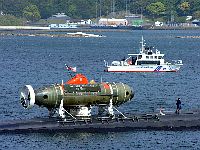
The Source for Navy News
Ships and Submarines Underway for Multinational Submarine Rescue Exercise
Story Number: NNS020426-08
Release Date: 4/26/2002 3:18:00 PM
![]()
By Journalist 3rd Class Wes Eplen, Commander, Task Force 76 Public Affairs
SASEBO, Japan (NNS) -- With high expectations, the ships of five nations with observers from seven others left Sasebo harbor to conduct submarine rescue exercises off the west coast of Kyusyu Island, Japan.
The multinational exercise Pacific Reach 2002, designed to improve submarine rescue capabilities, kicked off April 22 with comments from the participating nation's commanders.
"In the hundred years of submarine history, unfortunately many accidents have occurred where the precious lives of submarine crews were lost," said the exercise's host, Japan Maritime Self Defense Force Vice Adm. Seizo Nakao. "Countries possessing submarines must make the greatest efforts to prevent such accidents. Nonetheless, even if very few accidents occur, we must still hone our submarine rescue skills."
Members of the U.S., Japan, Australia, Republic of Korea and Republic of Singapore navies will participate in Pacific Reach, with observers from Indonesia, the United Kingdom, Canada, Chili, France, China and India. The exercise will include several underwater events, including submarine rescue exercises that will cross-deck the countries' various deep submersible rescue vehicles (DSRV).
The first event in the exercise was a dive medicine symposium, held in Sasebo, Japan April 23-24. The symposium was the first of its kind.
The major concerns of dive medicine include decompression sickness, saturation, hypothermia, burns, hypoxia, near drowning, toxic gas exposure, cardiac complications and psychological trauma. Other issues and medical concerns were also discussed at the medical symposium. Studies were presented on subjects extending from new technologies and products for treating survivors and extending survival time inside a disabled submarine, to medical storage space aboard a submarine and the handling of mass casualties aboard a rescue support ship.
"Medical supplies obviously vary widely between 10 different nations and it is hard to predict what supplies might or might not be available to a submarine provider," said Royal Australian Navy Lt. Cmdr. Sarah Sharkey. "And space is always a concern," she said.
Pacific Reach is intended not only to improve submarine rescue capabilities, but also to familiarize the different nations with just such issues. Nations could very easily have to rely on each other's aid to rescue the crew of a disabled submarine.
"Since there are only eight U.S. submarines capable of attaching a DSRV and their operations could place them days away from a potential rescue location, the possibility exists that the U.S. would request the assistance of another country," said Capt. Dale Nees, commander of Submarine Development Squadron Five, and U.S. Navy commander for the exercise.
"In our view, the merit earned through participation in multilateral exercises is not limited to improving the Self Defense Force's skills," said Yoshihiko Yamashita, Japan's parliamentary secretary for defense. "Through joint drills and exchanges of ideas, multilateral exercises make a significant contribution to promoting mutual understanding and confidence building among countries."
Pacific Reach is the first multinational exercise hosted by the JMSDF. It is only the second Western Pacific submarine rescue exercise, with the first being conducted off the coast of Singapore two years ago.
"I believe we can enhance our mutual understanding and mutual trust by exchanging our opinions face to face as representatives of the participating nations and as fellow naval officers and enlisted men during this exercise, not only while at sea, but also during symposiums and meetings at various levels," Nakao said.
For more information on Navy submarines, go to, http://www.chinfo.navy.mil/navpalib/ships/submarines/.
E-mail this story to a friend | Send a comment about this story
|
All Any Exact |
|
